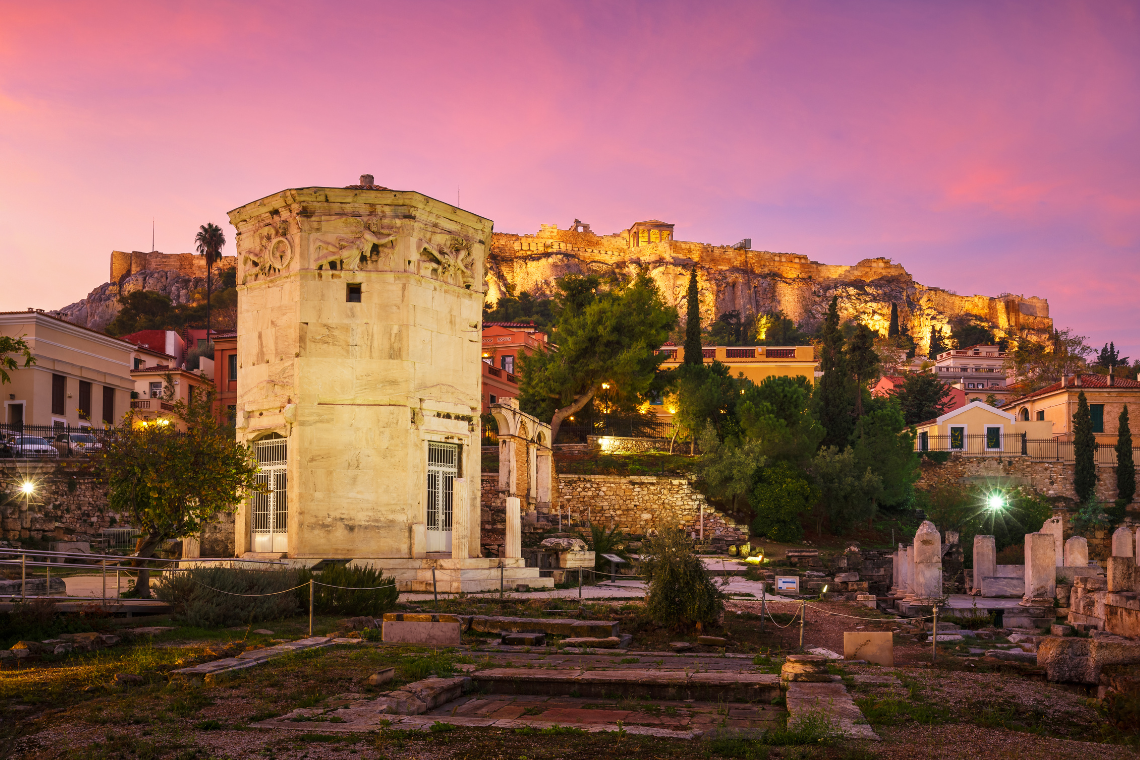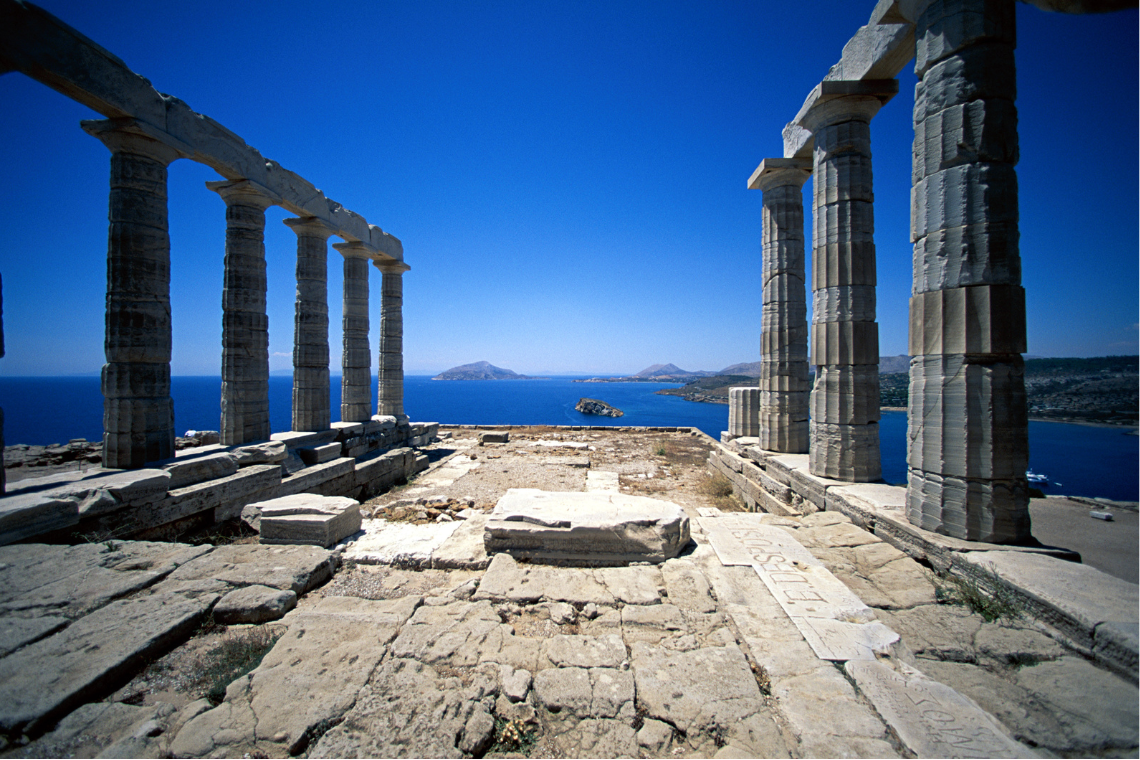BOOK NOW: Percy Jackson Mythology Tour of Acropolis & Acropolis Museum
Group Type
Small Group, Private
Tips for Visiting the Acropolis
- Avoid peak hours: Visit the Acropolis early in the morning or late afternoon to minimize crowds and enjoy a more peaceful experience.
- Wear comfortable shoes: The grounds consist of uneven terrain and marble paths, so proper footwear is essential for a comfortable experience.
- Bring water and sun protection: Stay hydrated and protected from the sun, especially during the warm summer months.
- Plan your visit: The best thing you can do is book your tickets in advance. Consider having a guided tour of the Acropolis to fully understand its value and historical significance.
2. Exploring the Ancient Agora
Insight into the Historical and Cultural Importance of the Site
The Ancient Agora of Athens was a significant public space in ancient Greece, functioning as the center for political, social, and economic life. As the birthplace of democracy and the meeting place of great philosophers like Socrates, Plato, and Aristotle, the Ancient Agora still holds a unique historical and cultural importance. The site provides visitors with an opportunity to explore the inspiring past of ancient Greek civilization.
Description of Notable Features within the Agora
Among the various attractions at the Ancient Agora, two of the most notable structures are the Temple of Hephaestus and the Stoa of Attalos. The Temple of Hephaestus, a grand Doric temple situated in the heart of the Agora, is one of the best-preserved temples from ancient Greece.
The Stoa of Attalos, reconstructed in the 20th century, represents a vital component of the agora's captivating history. This magnificent building contained numerous shops and functioned as a bustling market in ancient times. Today, the structure includes the Museum of the Ancient Agora, exhibiting an impressive collection of artifacts from the site's long history.

The Ancient Agora in Athens - Credits: milangonda/Canva
Recommendations for Guided Ancient Agora Tours
To fully appreciate the beauty and significance of the Ancient Agora, visitors are strongly encouraged to take a guided tour. Knowledgeable tour guides can provide valuable insights into the ancient Greek history, art, and culture that shaped the site. These tours typically last for a few hours and cover the essential attractions within the site.
3. Wandering Through Plaka
Plaka, known as the most picturesque neighborhood in Athens, boasts a history of more than 3,500 years. Its charming atmosphere and unique architecture make it one of the most beautiful places to visit in Athens. As you stroll through Plaka's narrow streets, admire the lovely neoclassical buildings and Acropolis glimpses in-between.
The blend of Byzantine churches, quaint shops, and colorful homes nestled in the area known as Anafiotika creates an unforgettable ambiance.
Highlights of Must-Visit Spots, Including Shops and Restaurants
Plaka has plenty to offer for those interested in shopping, dining, and immersing themselves in its rich history. With numerous shops selling jewelry, clothes, ceramics, and souvenirs, there's something for everyone. Stop by the lively Monastiraki Square to experience the bustling flea market that attracts both locals and visitors alike.
For gourmands, Plaka is replete with sidewalk restaurants and family-run taverns offering authentic Greek cuisine. The neighborhood's cafes, restaurants, and souvlaki joints provide a delightful opportunity to savor local dishes.
Suggestions for Experiencing the Local Culture
To truly appreciate the local culture, we recommend spending time exploring Plaka's historical attractions. Visit the Roman Agora and the Tower of the Winds, both remarkable monuments located in the heart of Athens. Art enthusiasts can enjoy traditional Greek art displayed within the neighborhood.
While meandering through Plaka, don't forget to visit the lesser-known gems throughout the area that showcase a different side of Athens. From the Choragic Monument of Lysicrates to the tiny Byzantine churches, Plaka offers a myriad of opportunities to connect with ancient and contemporary Greek culture.
4. Discovering the National Archaeological Museum

National Archaeological Museum in Athens - Credits: Andrey Khrobostov/Canva
Overview of the Museum's Collections and Significance
The National Archaeological Museum is definitely one of the best things to do in Athens. It is the largest archaeological museum in Greece and one of the most important museums in the world devoted to ancient Greek art. Established in the 19th century, it houses and protects numerous artifacts from all over Greece, showcasing their historical, cultural, and artistic value. Within this unique institution, you'll find collections spanning from 7000 BC to 500 AD, including galleries of ancient Egyptian and Cypriot antiquities.
Highlighting Key Artifacts and Exhibitions
As you journey through the museum, you will encounter several collections that provide vivid glimpses into Greece's rich history:
- Bronze Age masterpieces: Admire the intricate craftsmanship and beauty of these ancient objects, from weapons to decorative items.
- Cycladic art: View the striking, minimalist figures that predate the Classical period and showcase the artistic style of the Cyclades.
- Mycenaean civilization: Gain insight into this influential civilization that shaped Ancient Greece through rare artifacts and funerary masks, such as the iconic "Mask of Agamemnon."
- Classical art and statuary: Marvel at the graceful and powerful statues from Greece's golden age that have inspired artistic expression for centuries.
- Roman, Hellenistic, and Byzantine periods: Explore the evolving art styles throughout the museum's chronological display such as mosaics, sculptures, and pottery.
Visitor Tips and Ideal Duration for a Visit
To fully appreciate the depth and breadth of the National Archaeological Museum's collections, set aside 2-3 hours for your visit. Since it's a large museum, you can find plenty of spots throughout to sit, relax, and take in the exhibits. Its layout and design cater to a comfortable visitor experience, ensuring you can navigate easily between the exhibits.
Located close to the central tourist area, you can reach the museum in a short walk or with a quick metro ride. The National Archaeological Museum is an essential stop for anyone interested in experiencing the core of Greece's art, history, and culture.
5. Experiencing the Panathenaic Stadium

Panathenaic Stadium in Athens - Credits: rabbit75_cav/Canva
Historical Significance of the Stadium
The Panathenaic Stadium, one of the most well-known Athens attractions, holds great historical significance. This all-marble stadium played a vital role in the ancient world, hosting the Panathenaic Games where athletes competed in various athletics events. In recent times, it was the stadium that hosted the first modern Olympic Games held in 1896.
Description of the Structure and Its Role in Modern Events
The Panathenaic Stadium is a stunning work of architecture, entirely made of marble and boasting a capacity of 50,000 spectators. Its horseshoe shape and rows of tiered seating are unique design features, creating an impressive atmosphere for visitors.
The stadium is still used today for various events, including concerts and athletics competitions, and it even had the honor of hosting the archery competition during the 2004 Olympic Games in Athens. Additionally, the stadium serves as the endpoint for the annual Athens Authentic Marathon, reinforcing its connection to athletics and the Olympic spirit.
Suggestions for Guided Tours
To fully appreciate the history and architectural beauty of the Panathenaic Stadium, visitors are encouraged to take one of the available stadium tours. Guided tours typically offer an in-depth look into the stadium's story, exploring its role in ancient times and modern-day events.
6. Enjoying a Day Trip to Cape Sounion - The Temple of Poseidon

Temple of Poseidon in Sounion - Credits: Brand X Pictures/Canva
If you love city escapes, the Athenian Riviera is a must during your visit. Located less than an hour from Athens, the Riviera is one of the most beautiful places in Attica. Accordingly, a day trip to Cape Sounion offers a delightful escape. The highlight of this excursion is the historic Temple of Poseidon, perched majestically atop the promontory.
This ancient temple was dedicated to the god of the sea, and its enduring columns command breathtaking panoramic views of the Aegean. Visitors can explore the well-preserved ruins, each weathered stone telling tales of antiquity. Of course, the allure of the temple is amplified during sunset.
From Athens: Percy Jackson Temple of Poseidon Tour
You can opt for various transportation means from Athens, from guided day tours to private transfers. To savor the site's charm fully, the best times to visit are early morning or late afternoon.
7. Relaxing at the Athens Riviera
After visiting the temple of Poseidon, a resplendent escape awaits you at the Athenian Riviera. The region boasts pristine beaches, inviting promenades, and numerous seaside attractions.
You can unwind on sandy shores, enjoying the Mediterranean sun, or take leisurely strolls along the bustling waterfront.
However, the Athens Riviera is not just about relaxation; it's a hub for water enthusiasts. Water sports like paddle boarding and snorkeling beckon those seeking an active respite.
The Riviera is also filled with charming seaside cafes and Greek cuisine restaurants with sea views. As the sun dips below the horizon, the coastline transforms into a romantic haven.
Frequently Asked Questions
What are the top attractions to visit in Athens?
Athens is home to a variety of historical and cultural attractions. In other words, there are countless things to do in Athens. As mentioned above, the most famous site in the city is undoubtedly the Acropolis. Other top attractions include the Ancient Agora, the Temple of Poseidon in Sounio, and the National Archaeological Museum.
Which neighborhoods in Athens offer the most interesting cultural experiences?
For a taste of local culture and history, visitors should explore neighborhoods such as Plaka, Monastiraki, and Psiri. Plaka, located at the foot of the Acropolis, is a charming area with narrow streets, neoclassical architecture, and vibrant cafes, shops, and galleries. Monastiraki and Psiri are known for their bustling flea markets, street art, and lively nightlife.
Can travelers cover the main highlights of Athens within 2 days?
While there are plenty of must-see in Athens, it's possible to explore the main highlights within a 2-day itinerary. Day one can be dedicated to visiting the Acropolis and surrounding sites, such as the Ancient Agora and the Temple of Olympian Zeus. On the second day, you can easily explore the National Archaeological Museum, and take a leisurely stroll through various neighborhoods.
What unique experiences can visitors find in Athens beyond the Acropolis?
Athens offers many unique experiences beyond ancient sites. Visitors can delve into the stories of Greek mythology, attend traditional Greek theater performances, or participate in a hands-on cooking class to learn about the local cuisine. Art enthusiasts can appreciate modern Greek art at the National Gallery and street art in the alternative districts.
Where are the best dining spots for authentic Greek food in Athens?
Authentic Greek cuisine can be found throughout Athens, but some particularly notable dining spots can be found in Plaka, Psiri, and Monastiraki. These neighborhoods are known for their diverse range of restaurants, tavernas, and street food vendors offering traditional dishes such as souvlaki, moussaka, and fresh seafood.
What are some hidden gems in Athens that most tourists don't know about?
Athens has many hidden gems that tourists often overlook. These can include lesser-known archaeological sites, such as the mysteries of ancient Greece, or unique museums dedicated to topics like modern Greek art and Olive oil production. Additionally, exploring Athens by strolling through off-the-beaten-path neighborhoods may unveil intriguing street art and lesser-known historical landmarks.




